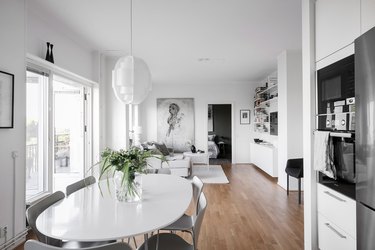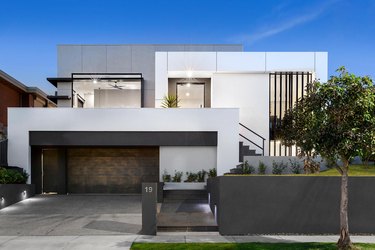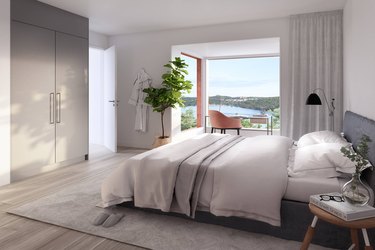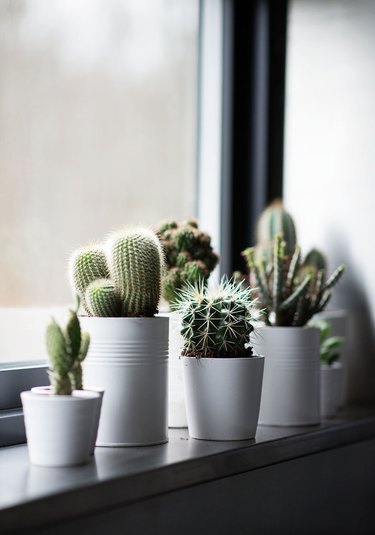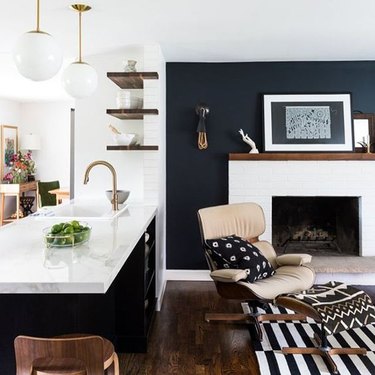Overview
We talk about it all the time, but what is modern style? Specifying the scope of today's styles is a trickier beast than one might expect; technically speaking, "modern" means "now" (and "contemporary" means "current"), so basically everything around us without conventionally accepted ties to a foregone period on the timeline of style counts as "modern style." It's usually easy to spot the architectural characteristics of a modern home: from the outside, modern homes are overwhelmingly simple (all right angles), while traditional homes tend to be more structurally complex (things get tricky with curves and triangles). And for the most part, the same holds true for modern decor: a number of ingredients go into making modern style, but the key ingredient is simplicity.
Origins
The age of modern design began in the 20th century with clean lines and hard angles. Around midcentury, some curves and color were added. Then, in the 1990s, a downsizing in the movement came, with a preference for minimalism. Since then, we've basically just been fine tuning the evolution of style that occurred over the course of the 20th century. But while the fluidity of fashions may complicate our endeavor to define modern style, we all know it when we see it thanks to a few key features. So if you're dreaming of designing a home with definitively modern style, be sure to keep the following elements in mind.
Minimalist exteriors and interiors
In a backlash against the so-called "decade of excess" that took place in the 1980s, the 1990s were all about downsizing. We stripped everything down to the bare minimum, even the color scheme, which pulled a 180º from rad neons to brooding black-and-whites (remember those Calvin Klein ads?). A philosophy of cleanliness and simplicity lies at the heart of all modern style, along with the mantra "less is more." Our fondness for minimalism has yet to diminish in the first two decades of the 21st century; modern style still places high value on clutter-free spaces, with sparingly (yet thoughtfully) chosen decor that enhances without overwhelming.
Neutral color palettes
Minimalism means minimizing noisy colors in addition to noisy clutter. A neutral color palette is a staple of modern style: black and white, grays, taupes, and beiges form the bases, while primary colors appear as accents in muted tones and pastel hues. Pro tip: Try using different shades and tints of the same color when creating your color scheme to nail a minimalist color palette (like the variety of grays in the bedroom pictured above).
Open concept floor plans
The adoption of the open concept floor plan is one of the biggest differences between modern and traditional homes. Modern-style homes are characterized by bright, open spaces, made possible by floor plans that allow one room to flow into another. Whereas the rooms in most traditional houses are separated by closed doors (or swinging doors, or door frames and hallways), most modern houses knock down as many walls as possible to create open spaces. This means that (apart from bedrooms and bathrooms) some modern houses don't really have "rooms" so much as "areas" — areas for cooking, areas for dining, and areas for living.
Try plants to add life
Visual symmetry is a big part of modern style, and using plants to create it is a great way to add some color and life to a modern home. A row of succulents on the windowsill or a pair of potted plants by the front door can add a much-needed touch of greenery. For bonus points, try color-coordinating a few stylish planters with your modern decor.
Subtle vintage accents
We know it seems contradictory, but a touch of the old actually fits in quite nicely with the new. Modern-style homes can take some flak for feeling cold, and some say that the style makes houses feel more like hotels than homes. But an understated shelf display of memorabilia, framed vintage prints, or even a midcentury-style light fixture can quiet naysayers by adding some character to the pseudo-austerity of minimalist decor. Modern style's philosophy of cleanliness and simplicity tends to make spaces feel shiny and new; subtle vintage accents create a lived-in atmosphere.
